Understanding the Dubai Metro Map and Its Zones
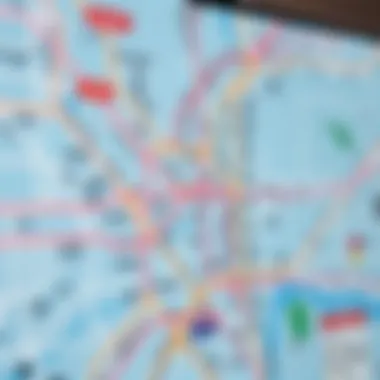

Intro
Navigating the vibrant city of Dubai can sometimes feel like trying to untangle a ball of yarn. With rapid development and expansion, the Dubai Metro presents an accessible lifeline for both residents and tourists alike. Understanding the intricacies of the Metro map and the zones it navigates is essential, as it informs everything from daily commutes to property investment decisions.
In this exploration, we will break down the Metro's function, its layout, and the implications of its reach on the bustling real estate market.
Market Trends
As the city continues to evolve, so does the real estate sector, shaping itself around easy access to the Metro’s stops. Understanding the current market trends is vital for anyone looking to invest in property or gauge the ongoing dynamics of the urban landscape.
Current Property Prices
The alignment of property costs with the accessibility provided by the Metro cannot be overstated. Areas near major stations can command premium prices due to their convenience, with neighborhoods like Dubai Marina and Downtown Dubai leading the charge. From luxury apartments to budget-friendly units, the proximity to a Metro station often sways buyer preferences and price points. Recent statistics indicate that properties located within a 5-minute walk of a Metro station see an increase of around 15% in their value compared to those further away.
Future Forecasts
Looking ahead, the potential for growth around the Metro zones remains significant. Analysts are keeping a keen eye on developments like the upcoming extension towards the Expo 2020 site and beyond. Predictions suggest that the property values could rise substantially—tipped to increase by as much as 10% to 20% in areas that will see direct Metro access in the next few years. This trend means that investors who can read these signals stand a good chance of profiting as others play catch-up.
Investment Opportunities
The Metro system does not just facilitate urban mobility; it is also a catalyst for smart investments. Knowing where to invest is half the battle in a dynamic market like Dubai.
High-ROI Areas
Investors should keep an eye on emerging precincts like Mohammed Bin Rashid City and Dubai South, as they are poised for substantial returns due to upcoming Metro expansions. Properties in these areas are currently more affordable, and with existing Metro connections, the likelihood of value appreciation is promising.
Financing Options
With the Dubai real estate market becoming increasingly competitive, financing remains a crucial element for prospective buyers. Options such as mortgages tailored for expatriates or government-backed schemes for first-time buyers provide a range of opportunities for those looking to dive into the market. These financial instruments can lower barriers to entry and allow for greater flexibility in purchasing decisions, especially in fast-growing zones.
"In an ever-evolving city, those who understand the maps—literal and metaphorical—hold the keys to future success."
For further detailed insights into city planning and zoning, consider exploring resources such as Wikipedia or Britannica. Engage with local forums like Reddit for community-driven insights or stay updated through the official Dubai government portals.
Prolusion to the Dubai Metro
The Dubai Metro stands as a impressive symbol of the city’s rapid modernization and urban planning. With its sleek design and extensive network, it not only serves as a public transport option but is a fundamental part of how Dubai operates. Understanding its layout, especially the map and the zones can be crucial for anyone living in or visiting the city. This introduction sets the stage for an exploration of the metro's structure and its vital role in Dubai's infrastructure.
Overview of the Metro System
The Dubai Metro commenced operations in 2009 and has made significant strides since then. Spanning two main lines - the Red Line and the Green Line - it covers over 75 kilometers of rail network. The system is fully automated, offering riders a smooth and timely experience. Each station is equipped with modern facilities such as elevators and escalators, making it accessible for everyone.
The layout of the metro system is designed with user-friendliness in mind. The stations are well-connected and provide easy access to key locations such as malls, airports, and business districts. On top of that, the entire system runs on a precisely timed schedule, keeping the frequency high during peak hours and ensuring that commuters reach their destinations on time.
Significance to Urban Development
The establishment of the Dubai Metro is a clear reflection of the city’s ambition to promote urban development in a sustainable and efficient manner. Its impact can be measured across various dimensions:
- Economic Growth: Enhanced connectivity boosts commerce, making it simple for businesses to thrive. Transporting employees and customers efficiently encourages investment in the areas surrounding metro stations.
- Environmental Benefits: Public transportation helps reduce traffic congestion and lowers carbon emissions by providing an alternative to car travel. This aligns with Dubai’s vision for a more sustainable city.
- Urban Planning: The metro has influenced the layout of the city. New residential and commercial developments frequently arise near stations due to the ease of access.
"The metro is not just a transport solution; it’s a catalyst for strategic progress in Dubai’s urban landscape."
In summary, the introduction of the Dubai Metro has not only improved transportation but has acted as a driving force behind the city’s evolution. It showcases the careful thought put into urban advancement, while also pointing to the future of transit not only in Dubai but across urban centers worldwide.
Navigating the Dubai Metro Map
When discussing the Dubai Metro system, navigating the Metro map emerges as a crucial focal point. The map itself is like a treasure map for residents and visitors alike, guiding them through this bustling city’s veins. Understanding the layout not only enhances one’s travel experience but is essential for efficient commuting. As the Metro connects key commercial districts, residential neighborhoods, and cultural landmarks, familiarizing oneself with its map serves as a gateway to unlock the best of what Dubai has to offer.
In essence, the Metro map is not a mere illustration; it’s a representation of connectivity and urban planning. Knowing how to read the map can prevent unnecessary detours, save time, and even reduce transportation costs. Understanding the different zones and stations enriches one’s journey, making it more strategic.
Layout and Design of the Map
The layout and design of the Dubai Metro map are thoughtfully crafted, balancing aesthetics and functionality. At first glance, one might notice vibrant colors representing various lines—a visual cue that reflects Dubai’s dynamic spirit. The most prominent lines include the Red and Green lines, running parallel to the city’s primary arteries, which makes them easy to follow.
The map employs a straightforward schematic design, resembling subway maps found in major cities worldwide. It uses symbolic station icons ensuring clarity amid the hustle and bustle. Each station is typically accompanied by a helpful indicator of nearby attractions, making it not only practical but also informative.
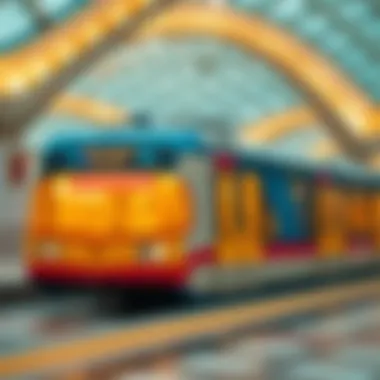
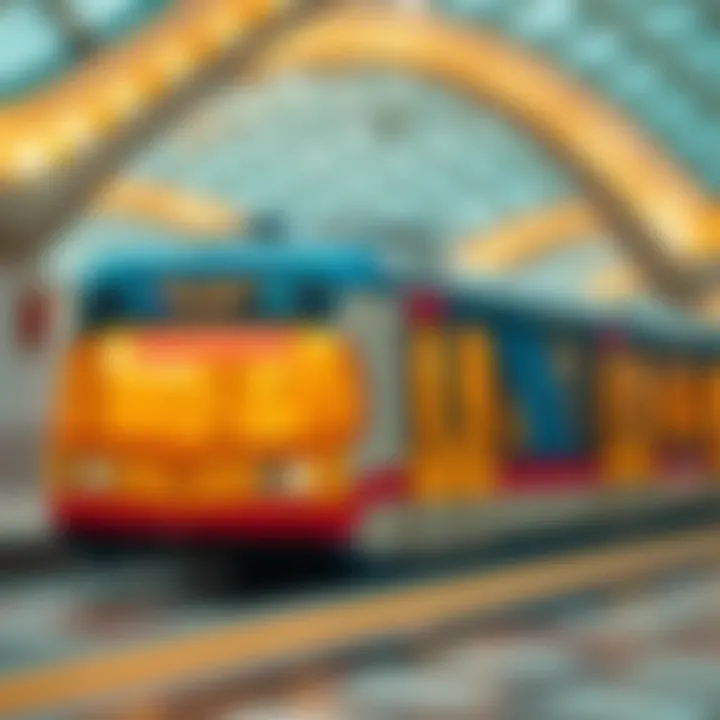
There’s also the benefit of vertical and horizontal alignments that guide passengers in a predictable manner. Potential riders can quickly assess the distance between stations, which is paramount for planning transfers or determining travel times.
Key features worth noting are the interchanges, which are strategically located at vital junctions in the city, creating a seamless transition between lines.
Key Stations and Interchanges
Navigating the Metro also necessitates an understanding of key stations and interchanges within the system. Some stations are particularly noteworthy due to their proximity to major developments and tourism hubs. For instance, the Burj Khalifa/Dubai Mall station, located near the world-famous Burj Khalifa, is not just a stop; it's an entryway to one of Dubai's chief attractions. The convenience it offers to tourists seeking to experience the grandeur of this iconic landmark is immeasurable.
Similarly, stations like Dubai Marina and Mall of the Emirates cater to a different audience—residential areas and shopping enthusiasts. These interchanges are effectively placed to maximize the flow of people.
In addition, Union Station stands out as a pivotal transfer hub, linking the Red and Green lines while serving as a bustling center of activity.
"Knowing the major stations not only aids in planning your route; it sets a foundation for deeper exploration of the city’s offerings."
Moreover, exploring the lesser-known stations can be an adventure in itself. Stations like Rashidiya lead to hidden gems that tourists often overlook. Each station adds to the rich tapestry of Dubai’s cultural landscape.
Navigating the Dubai Metro map is more than just travel; it’s an adventure that unfolds with every stop. Whether you’re an investor assessing property values in proximity to the Metro, or an expatriate discovering what each area has to offer, understanding the map is fundamental to truly enjoying Dubai's urban fabric.
Understanding the Zones of Dubai Metro
The layout of the Dubai Metro is not just a marvel of modern engineering; it also reflects the intricate urban planning of the city. Understanding its zones is crucial for navigating not only the Metro but also the broader urban landscape of Dubai. Each zone plays a distinct role in facilitating efficient transportation, managing fares, and offering residents and visitors alike an enhanced commuting experience.
Getting acquainted with these zones opens up a plethora of possibilities for commuters and investors. Knowing where the zones lie can help individuals plan their journeys better, identifying the quickest routes and understanding the value of the locations around them. This becomes particularly significant for those who rely on public transport daily or are looking to invest in property in close proximity to the Metro.
Zone Classification Explained
The Dubai Metro zones are categorized based on geographical demarcations, making the system easy to comprehend yet intricate in its operational details. The city is divided into several zones. Each zone encompasses a range of metro stations and extends outward to define the fare system. In total, the Metro has a tiered structure primarily consisting of one, two, and three zones.
- Single Zone: The most straightforward fare structure, applying when you travel between two stations within the same zone.
- Two Zones: If your journey crosses the boundary from one zone into another, this fare applies, attracting a fee suitable for the increased distance covered.
- Three Zones: If the travel spans across three distinct zones, passengers should expect a higher fare reflecting the extended journey.
In a nutshell, the zoning effectively streamlines travel within the Metro and makes pricing transparent for users. Knowing these classifications helps in planning adequate budgets when gearing for the journey.
Impact on Fare Structure
The zones have a direct bearing on the fare structure of the Dubai Metro system. This segmentation allows for a reasonably fair pricing strategy, ensuring that passengers pay only for the distance traveled. Essentially, the fare system operates on a pay-as-you-go principle that aligns closely with the zoning mechanism.
This fare structure has several implications:
- Affordability: For regular commuters, knowing that they can navigate within one zone at a nominal fee makes public transport more attractive. It’s a financial boon, especially for those who must travel frequently.
- Accessibility: Understanding the fare segmented by zones means that anyone can calculate their travel costs upfront, making public transport a more viable option compared to owning a private vehicle or relying on taxis.
- Recommendations for Investors and Buyers: Areas that lie adjacent to Metro stations in lower fare zones could potentially see higher property demand, bolstered by the lower commuting costs associated with those regions.
"Public transport pricing should never be a puzzle. The Dubai Metro has simplified this with its zoning, making it straightforward for everyone."
With an awareness of both the zone classifications and their impact on fare structures, users can not only navigate the Dubai Metro more efficiently but also enhance their overall understanding of real estate dynamics in the area.
For those interested in comparing this structure to other transit systems, useful resources include wikipedia.org and reddit.com.
Understanding these elements can provide valuable insight into the way public transport shapes urban living in Dubai.
Ticketing Systems and Their Functions
The ticketing system used in the Dubai Metro is a critical component, as it not only facilitates smooth travel for passengers but also reflects the efficiency and modernity of the transportation network. Understanding how these systems work can greatly enhance the experiences for both locals and visitors, saving time and ensuring they get the most out of their journeys.
Types of Tickets Available
Dubai Metro offers several ticketing options to cater to different passenger needs and travel patterns. Here's a look at the primary types of tickets available:
- Single Journey Ticket: Perfect for those making one-off trips. This ticket is valid for a single ride within the selected zones. It’s a simple option for visitors who might not use the metro frequently.
- Return Ticket: For travelers looking to make a round trip in one day, this ticket offers convenience and a slight price advantage compared to purchasing two single journey tickets.
- Daily Pass: This allows unlimited travel within the chosen zones for an entire day. Ideal for tourists or business professionals who have multiple appointments across the city on the same day.
- Monthly Pass: For regular commuters, a monthly pass offers significant savings as it permits unlimited travel throughout the month across selected zones.
Overall, each ticket type is designed to accommodate a variety of travel patterns, ensuring that everyone can navigate the city effortlessly.
NOL Card: Usage and Benefits
Perhaps the most innovative part of Dubai’s ticketing system is the NOL Card. This smart card system revolutionizes not just how passengers pay for their Metro rides but also simplifies the process, making it user-friendly and efficient.
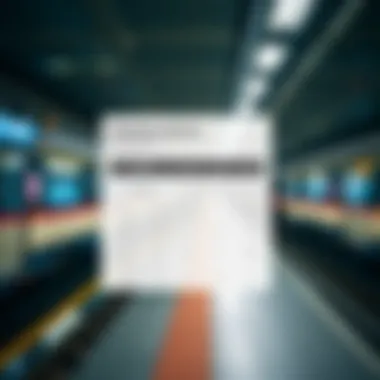

- Ease of Use: The NOL Card can be tapped at any metro station or on buses and water taxis, making transitions between different modes of transport seamless. Passengers just need to maintain a balance on their cards and can reload them at machines located in stations.
- Discounts and Offers: Using a NOL Card provides a 10% discount on fares compared to single journey tickets. Over time, this can turn into substantial savings, especially for frequent travelers.
- Accessibility: The card is not limited to the Metro; it can also be used across various modes of public transport within Dubai, including buses and trams. It promotes a holistic approach to urban mobility.
- Tracking and Management: Passengers can track their travel history and manage their balance through the RTA’s application, allowing for greater control and planning of their journeys.
"The NOL card isn't just a ticket; it's a passport to the modern, connected city that Dubai aspires to be."
Overall, the ticketing system within the Dubai Metro structure serves as a fundamental piece, not only enhancing the ease of travel but also supporting the integration of the city's broader transport strategy. For investors and expatriates, understanding these components can aid in a smoother transition into daily life in Dubai.
The Role of the Metro in Real Estate Trends
The Dubai Metro is more than just a mode of transport; it has become a catalyst for real estate development in the city. Its extensive network, linking various neighborhoods and key areas, often plays a crucial role in determining property values. For investors and property buyers, understanding this dynamic is essential, especially when considering long-term investments in a rapidly growing city like Dubai.
Proximity to Stations as a Value Add
Being close to a Metro station can significantly enhance a property's appeal. This has been noted numerous times in studies tracking real estate trends in Dubai. Here are a few factors to consider:
- Convenience for Residents: People seek the ease of commuting, and homes near Metro stations provide that convenience. The reduction in commute time is often a strong selling point.
- Increased Demand: As more people become aware of the Metro’s advantages, demand for residential properties near stations rises. This heightened demand tends to push property prices up.
- Developer Incentives: Many developers recognize the importance of proximity to transit. This can lead to innovative residential projects that offer attractive amenities, thereby further driving up value.
"Properties located near Dubai Metro stations often see a price increase ranging from 10 to 30% compared to those farther away."
In a city driven by growth, such statistics ring true. The Metro's role in enhancing accessibility cannot be overstated; it connects people not just to destinations but also to potential investments.
Analyzing Property Prices Near the Metro
When evaluating the real estate market, one must analyze how proximity to the Metro influences pricing. Several factors come into play:
- Market Trends: Data often reveals that properties within walking distance to Metro services command higher rates. Investors want the assurance that their asset will appreciate over time, and proximity to rapid transit helps ensure that.
- Rental Yields: The demand for rental properties near Metro stations typically leads to robust rental yields. This makes such investments particularly attractive for landlords.
- Future Developments: Areas near Metro stations are often included in future urban plans. Understanding planned developments can provide insight into potential property appreciation, making it an essential factor for buyers.
To fully appreciate the impact of the Metro on real estate, potential buyers should conduct market analyses with a specific focus on average property prices compared to distance from Metro stations. Websites like Property Finder can provide valuable insights.
Overall, the Dubai Metro is not just infrastructure; it's a powerful player in the real estate market dynamics. For those looking to invest or relocate, understanding its implications is vital for making informed decisions.
Comparative Analysis with Other Transit Options
When examining how to navigate the bustling city of Dubai, it's imperative to weigh various transit alternatives. The Dubai Metro is a prominent choice, yet not the only option. This section will delve into how the Metro stacks up against other modes of transportation in the city, such as road travel and integrated transport networks. By highlighting their respective benefits and drawbacks, we can better understand the dynamics shaping urban mobility in this rapidly evolving metropolis.
Metro vs. Road Transportation
At first glance, the Dubai Metro shines brightly compared to road transportation. For starters, it offers a reliable and efficient, often faster alternative to driving in the heavy congestion that can plague Dubai's roads, particularly during rush hour. Here are some notable points of comparison:
- Speed: Trains run frequently, and because they don't need to deal with traffic, they can often whisk passengers to their destinations in record time.
- Cost-effectiveness: Metro fares tend to be cheaper, and with the availability of the NOL Card, commuters can enjoy further savings and seamless transitions.
- Environmental impact: The Metro operates on electricity, offering a greener option compared to vehicles that rely on fossil fuels, which is significant in a city aiming for sustainability.
However, it's essential to acknowledge certain limitations of the Metro:
- Coverage: While the Metro does connect major districts, it doesn’t reach every nook and cranny of Dubai. Commuters may need alternative transport to bridge that gap.
- Time constraints: Though faster in traffic, the Metro may not always align with the specific schedules of travelers, especially for late-night outings.
In summary, while the Metro presents attractive benefits over road travel, its limitations require considerations of mixed transport options based on individual needs.
Integration with Other Forms of Transport
A unique strength of the Dubai Metro lies in its integration with various other transportation modes, which enhances its function in the public transit ecosystem. When we consider how the Metro interacts with buses, taxis, and even the water taxi service, it becomes clear how effective this interconnected system can be:
- Buses: Numerous bus routes converge at Metro stations, allowing travelers to conveniently switch to another form of transport without missing a beat. This kind of connectivity strengthens the overall efficiency of navigating the city.
- Taxis: For those journeys that require more flexibility, taxis are readily available outside Metro stations. This option allows passengers to reach destinations not directly served by the Metro quickly.
- Water Taxis: Dubai’s awe-inspiring waterways can also be part of the travel experience, with water taxis linking to certain Metro stations, thereby broadening the scope of accessible locations.
This integration signifies a well-oiled transit machine that doesn't restrict mobility to just one option but rather encourages users to leverage multiple transport forms to suit their individual needs.
"The true test of any transit system is not just its individual components but how well they work together. The Dubai Metro's integration with other transport makes it a cornerstone of urban mobility."
In summary, understanding how the Dubai Metro holds up against road transportation and fits within the broader transport framework is crucial for discerning travelers, property owners, and urban developers alike. The findings from this comparative analysis enrich one’s perspective on Dubai’s dynamic transit landscape.
Future Developments in the Metro System
As the city of Dubai continues to grow and evolve, the importance of the Dubai Metro system becomes even more pronounced. Future developments in the metro system play a pivotal role in addressing urban mobility challenges. Expanding the network not only accommodates the increasing population but also enhances the overall infrastructure of Dubai. With an eye toward sustainable growth, understanding these developments can shed light on their benefits for residents and investors alike.
Upcoming Lines and Expansion Plans
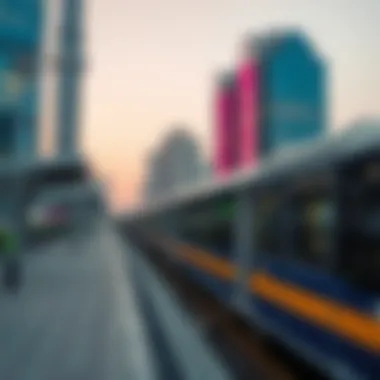

Dubai's metro expansion plans aim to extend the network’s reach to underserved areas, aligning with the city's ambitions to ensure efficient transportation for all. The modernization of existing lines and the construction of new routes are central to these plans. For instance, the development of the Blue Line is a notable endeavor, which promises an additional 15 kilometers on the existing route.
Some important aspects of the upcoming expansions include:
- Connecting Vital Districts: The new lines will link essential business hubs with residential areas, making commuting more convenient.
- Improving Accessibility: The focus on underserved neighborhoods aims to boost the accessibility of public transport, reducing reliance on cars.
- Reducing Traffic Congestion: With efficient mass transit options, it is anticipated that road traffic will decrease significantly, alleviating congestion during peak hours.
- Environmentally Friendly Transport: The metro system contributes to lowering carbon footprints, aligning with Dubai's goals for a greener city.
"The expansion of the Dubai Metro is more than just physical infrastructure; it symbolizes a commitment to a sustainable urban future."
Technological Advancements in Metro Operations
In tandem with infrastructure expansion, technological advancements are shaping the efficiency of the Dubai Metro. Innovations in operations not only streamline processes but significantly enhance the commuter experience. Key technological implementations include:
- Smart Ticketing Solutions: The introduction of automated systems for ticket purchases and validations speeds up passenger flow, decreasing wait times at stations.
- Real-Time Tracking: The availability of real-time updates on train schedules through mobile apps boosts convenience for riders, aiding in easier planning of commutes.
- Advanced Safety Mechanisms: State-of-the-art technology ensures safety through surveillance and emergency communication systems embedded in all trains and stations.
- Sustainability Initiatives: Solar panels are being integrated into the infrastructure, supporting an eco-friendly approach to energy consumption for operational needs.
The adaptability of the Dubai Metro in embracing these technological advancements has positioned it as a leader in urban transport solutions. As the city invests in these future developments, the implications for property values and overall urban livability become increasingly favorable.
For further reading on Dubai's transport strategies, visit the Dubai Roads and Transport Authority. With an ambitious roadmap ahead, the Dubai Metro is set to be a cornerstone in the city’s quest for sustainable urban growth.
Challenges Facing the Dubai Metro
The Dubai Metro is not just a means of transport for the bustling city, it is a symbol of progressive urban planning. However, like any major urban transit system, it faces a range of challenges that can affect its efficiency, usability, and overall experience for riders. Understanding these challenges is crucial for investors, agents, expatriates, and buyers who navigate this urban landscape.
Operational Constraints
Operational constraints are a pervasive issue for many metro systems, including Dubai’s. These constraints can arise from various factors such as limited lines, maintenance schedules, and peak usage times. Each of these can lead to overcrowding during rush hours, leaving commuters feeling like sardines in a can.
Facilities like the Dubai Metro must manage operational hours to allow for necessary maintenance, yet this often means service interruptions, especially at night. Users might have to plan their journeys meticulously, particularly if they rely on the Metro for their day-to-day activities, such as commuting to work or attending appointments. In addition, the current infrastructure might struggle to keep pace with the city's rapid expansion; new residential developments are constantly popping up along various metro lines. This creates a disparity between service capacity and demand, leaving some stations consistently oversubscribed.
- Increased Journey Times: Longer waits and more crowding can lead to increased journey times, making the metro less appealing compared to other transport options, like taxis.
- Resource Allocation: Prioritizing funds between expanding lines and upgrading current systems can prove difficult, often leading to inconsistent service.
User Experience and Accessibility Issues
User experience is something that can make or break a commuter's opinion of the Dubai Metro. Accessibility, in this context, involves more than just easy access to stations. It extends to how comfortably individuals can use the system and whether it meets the needs of a diverse population, including those with disabilities. While the Metro has made strides in becoming more accessible, several challenges remain.
Station designs, while modern and efficient, sometimes neglect crucial elements like clearer signage or intuitive layouts, especially for first-time users. Furthermore, elderly passengers or those with mobility issues might find certain transitions between modes of transport challenging. The availability of elevators and escalators is inconsistent across stations, which can be frustrating for those who need them.
"A seamless transition between different transport systems is key to enhancing user satisfaction and operational efficiency."
Moreover, the introduction of multiple ticketing options and pricing structures can be confusing. If users don’t understand how to navigate the fare system, they may feel discouraged from using the Metro altogether, leading to fewer passengers and subsequently lower revenues for the service.
Combating these user experience issues involves several measures:
- Training Programs: Providing better training for employees to assist users effectively.
- Regular Audits: Conducting routine audits of accessibility features.
- Feedback Mechanism: Establishing a robust feedback mechanism that allows users to voice their experiences and concerns.
In summary, while the Dubai Metro is a vital cog in the city’s infrastructure, operational constraints and user experience challenges present significant hurdles. Addressing these issues will not only enhance the journey for current users but also position the Dubai Metro as a leading transit system in global urban contexts.
Finale: The Metro's Impact on Life in Dubai
As we wrap up our exploration of the Dubai Metro, it's clear that this system is not just a mode of transportation—it's a vital thread in the fabric of urban life. The Metro’s impact transcends mere commuting; it reshapes patterns of living, working, and playing within the city.
Recap of Key Insights
The Metro plays a pivotal role in connecting various neighborhoods and commercial areas, making it easier for residents to engage with the city's vibrant culture. We’ve learned that:
- Zone Structure: The classification of zones not only organizes the fare system but indicates accessibility and desirability of different areas.
- Real Estate Influence: Proximity to Metro stations has a profound influence on property values. Homes near these hubs often see increased demand, which can benefit investors and residents alike.
- Urban Development: The Metro has catalyzed further infrastructure development, creating a cascading effect on businesses and housing options along its routes.
This system doesn’t just serve tourists; it enhances the daily lives of everyone who calls Dubai home. The ease of transport allows for greater freedom when choosing where to live, while also promoting local commerce by connecting people to shops, restaurants, and entertainment.
Looking Ahead: The Future of Transit in Dubai
Looking forward, the potential for further evolving the Metro system is vast.
- Expansion Plans: Upcoming line extensions are set to enhance the connectivity even more, reaching previously underserved areas of the city. As these expansions unfold, we can expect notable shifts in demographic trends and urban development.
- Technological Enhancements: Innovations like real-time tracking and improved ticketing systems will streamline user experience, making the Metro even more user-friendly. The integration of smart technologies could further facilitate seamless transfers between different transit options, enhancing connectivity across Dubai's transport network.
- Sustainability Focus: With the ongoing global push towards sustainability, the Metro’s role in reducing traffic congestion and lowering emissions aligns with Dubai’s broader goals of environmental responsibility.
In summary, the Dubai Metro is more than a mere transportation system—it’s an essential component of Dubai's future growth. Understanding its impact on life in the city unlocks insights not just for everyday travelers, but also for investors looking to navigate the ever-evolving landscape of this dynamic metropolis.
"Investing in the infrastructure of the future is investing in the future itself.
For more detailed insights, you may check Dubai Metro Information, which provides further stats and maps on the future evolution of the Metro.



